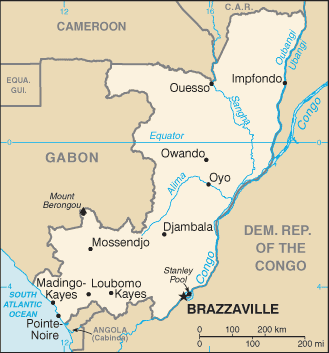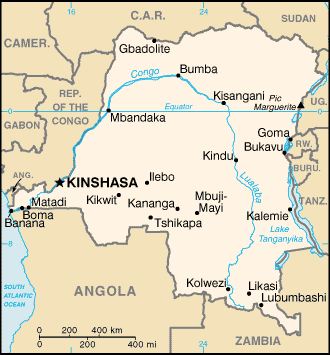| The Very Latest Coins... |
| Congolese Coins |
|

|
|
|

|
|
|
Which Congo? - A Tale of Confusion & Ignorance
We would not expect everybody to be aware that there are two Congos, but it is a fact that there are in fact two different, but adjacent countries, which could popularly be called Congo.
Most numismatists and philatelists would probably be aware of this simple fact, especially if they were interested in world coins or stamps, rather than those of their own country of origin or residence.
When creating this page, we came across a fact that absolutely astounded us, and we will say more about it below, but first, to remove any confusion, we will discuss both of the national entities in question.
Republic of Congo
According to the CIA:
Upon independence in 1960, the former French region of Middle Congo became the Republic of the Congo. A quarter century of experimentation with Marxism was abandoned in 1990 and a democratically elected government took office in 1992. A brief civil war in 1997 restored former Marxist President Denis SASSOU-NGUESSO, and ushered in a period of ethnic and political unrest. Southern-based rebel groups agreed to a final peace accord in March 2003, but the calm is tenuous and refugees continue to present a humanitarian crisis. The Republic of Congo was once one of Africa's largest petroleum producers, but with declining production it will need to hope for new offshore oil finds to sustain its oil earnings over the long term.
Democratic Republic of Congo
According to the CIA:
Established as a Belgian colony in 1908, the Republic of the Congo gained its independence in 1960, but its early years were marred by political and social instability. Col. Joseph MOBUTU seized power and declared himself president in a November 1965 coup. He subsequently changed his name - to MOBUTU Sese Seko - as well as that of the country - to Zaire. MOBUTU retained his position for 32 years through several sham elections, as well as through the use of brutal force. Ethnic strife and civil war, touched off by a massive inflow of refugees in 1994 from fighting in Rwanda and Burundi, led in May 1997 to the toppling of the MOBUTU regime by a rebellion backed by Rwanda and Uganda and fronted by Laurent KABILA. He renamed the country the Democratic Republic of the Congo (DRC), but in August 1998 his regime was itself challenged by a second insurrection again backed by Rwanda and Uganda. Troops from Angola, Chad, Namibia, Sudan, and Zimbabwe intervened to support KABILA's regime. A cease-fire was signed in July 1999 by the DRC, Congolese armed rebel groups, Angola, Namibia, Rwanda, Uganda, and Zimbabwe but sporadic fighting continued. Laurent KABILA was assassinated in January 2001 and his son, Joseph KABILA, was named head of state. In October 2002, the new president was successful in negotiating the withdrawal of Rwandan forces occupying eastern Congo; two months later, the Pretoria Accord was signed by all remaining warring parties to end the fighting and establish a government of national unity. A transitional government was set up in July 2003. Joseph KABILA as president and four vice presidents represented the former government, former rebel groups, and the political opposition. The transitional government held a successful constitutional referendum in December 2005 and elections for the presidency, National Assembly, and provincial legislatures in 2006. KABILA was inaugurated president in December 2006. The National Assembly was installed in September 2006. Its president, Vital KAMERHE, was chosen in December. Provincial assemblies were constituted in early 2007, and elected governors and national senators in January 2007.
Westminster Coin Experts
Actually, it may be rather unfair of us to call the people at Westminster Collections experts, as they do not style themselves as such.
However, most of their customers probably expect them to know something about the coins (and stamps) they sell, and the countries that issued them. They would be wrong!
Among the huge selection of various world coins in our stock, we have a number of 2003 coins issued by the "Republique Democratique du Congo", or translated into English, the "Democratic Republic of Congo". So far, so good.
The "Certificate of Authenticity" issued with each coin by Westminster, states "Issuing Country - Congo Republic"!
We could not believe our eyes, and rather unkindly fell about laughing when we spotted this glaring error.
We have criticised Westminster before, but this one beats all. We also sometimes criticise the British Royal Mint, but at least they know the difference between two countries! We try to ensure that any criticism we make, especially if it is negative criticism, scrupulously fair. In this example, we can only conclude that the marketing people at Westminster must be gifted with an incredible level of ignorance. We could excuse a simple mistake, we are all human, and we all make errors, but this error is on a document which any buyer of these coins would expect to have a certain legal status, and to have been prepared with a reasonable amount of care.
We wonder if anybody at Westminster has yet noticed or cares about this ridiculous mistake.
Republic of Congo
Democratic Republic of Congo
2003 Historic Cars
Order Form - UK
Order Form - USA
Order Form - EU
Order Form - Rest of World
Coins Wanted
We make an active market in almost all world coins, silver or otherwise, including Congo. If you have any of these coins to sell, please contact us, or post them to us for appraisal and offer.
| ...at the Official Issue Prices |
|
32 - 36 Harrowside, Blackpool, Lancashire, FY4 1RJ, England.
Telephone (44) - (0) 1253 - 343081 ; Fax 408058; E-mail: info@chards.co.uk The URL for our main page is: https://24carat.co.uk | Web Design by Snoop |